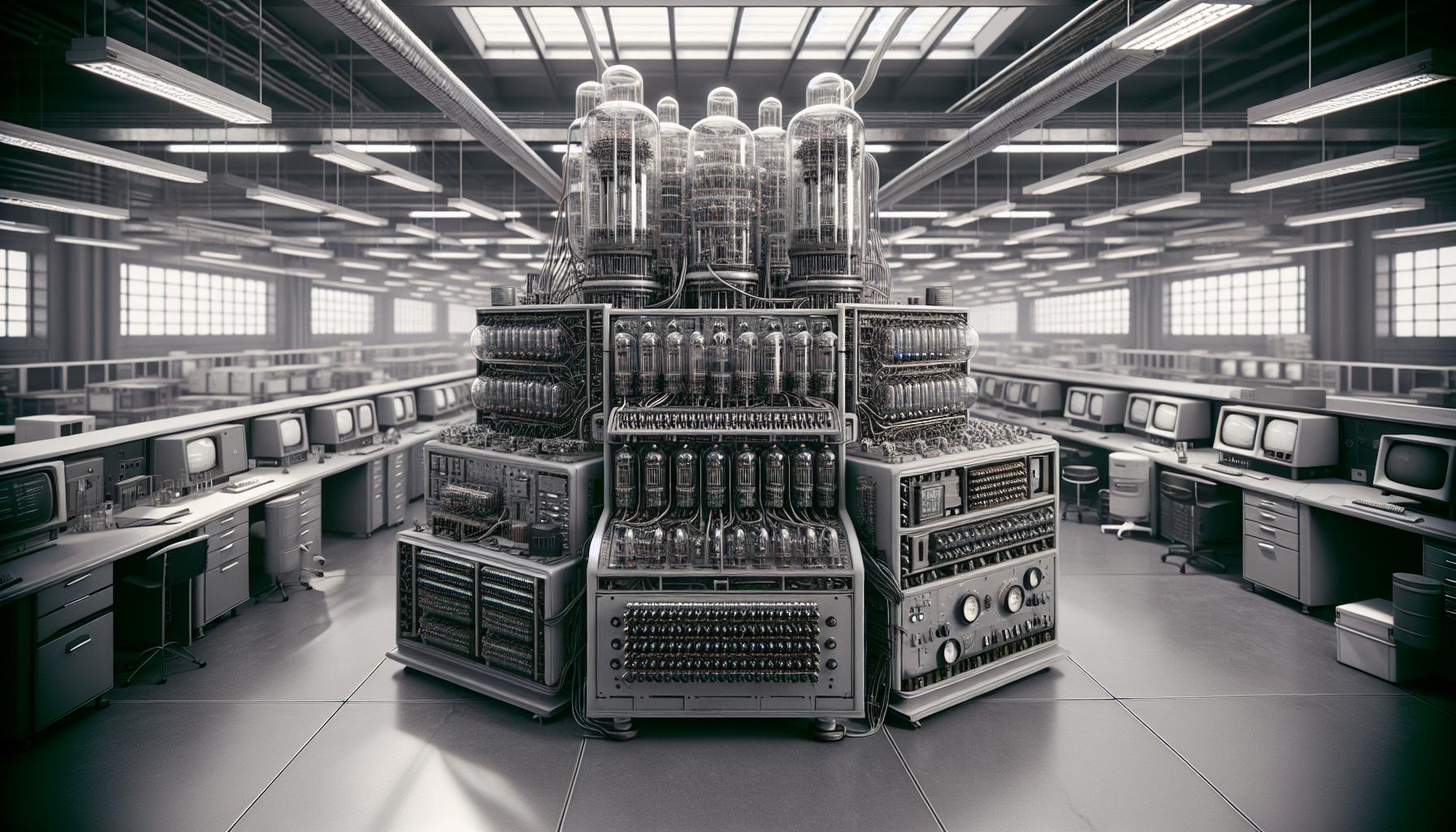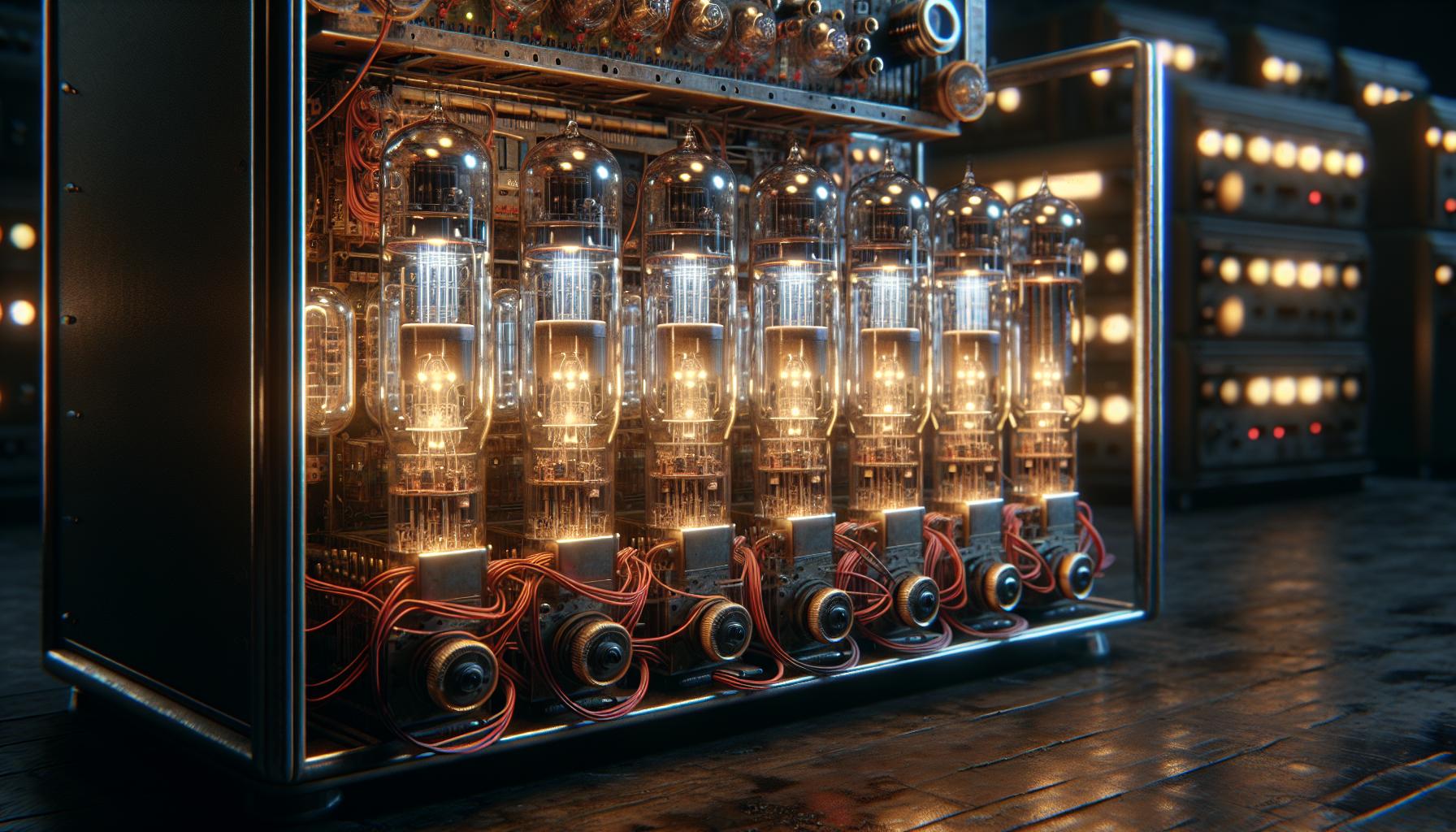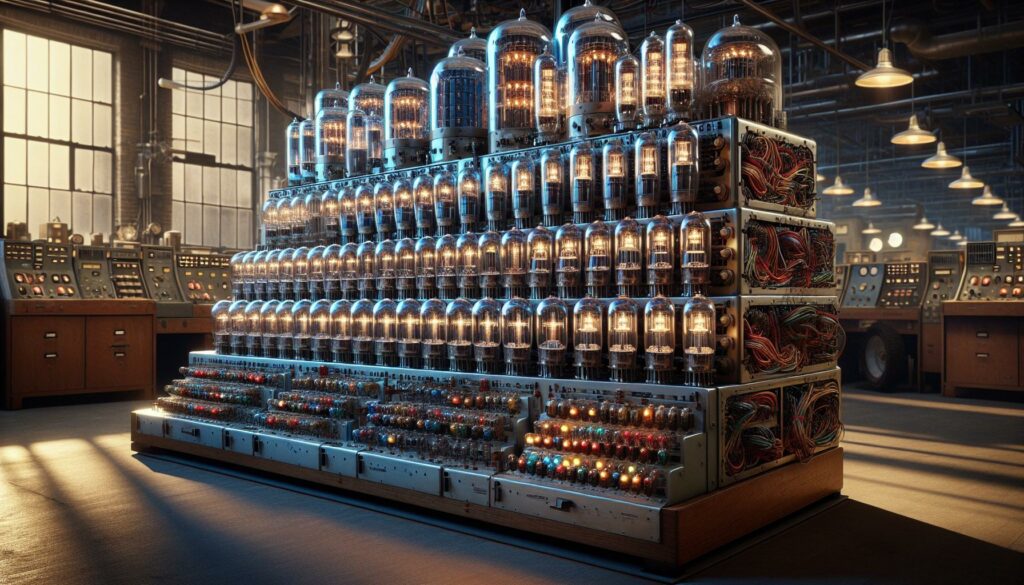I’ve always been fascinated by the evolution of computers, and vacuum tube computers hold a special place in computing history. These early electronic giants, powered by thousands of glowing vacuum tubes, laid the groundwork for today’s digital revolution. While they may seem primitive by modern standards, they represented a quantum leap in computational power during the 1940s and 1950s.
As I explore the world of vacuum tube computers, I’m reminded of iconic machines like the ENIAC and UNIVAC I. These room-sized behemoths consumed enormous amounts of power and required constant maintenance, yet they revolutionized everything from scientific research to business operations. The warm glow of their vacuum tubes and the rhythmic clicking of their relays tell a story of human ingenuity and the dawn of the computer age.
Key Takeaways
- Vacuum tube computers, developed in the 1940s-1950s, were the first electronic computing systems, using thousands of vacuum tubes to perform calculations and data processing tasks
- Notable machines like ENIAC and UNIVAC I revolutionized computing despite their massive size, with ENIAC containing 17,468 vacuum tubes and performing 5,000 operations per second
- These early computers faced significant challenges including high power consumption (150 kilowatts for ENIAC), constant maintenance requirements, and frequent tube failures requiring 24/7 technician teams
- Key pioneers like John von Neumann, Grace Hopper, and Alan Turing made breakthrough contributions during the vacuum tube era, establishing fundamental computing concepts still used today
- The transition to transistors in 1956 marked the end of the vacuum tube era, offering dramatic improvements in size, efficiency, and reliability while building on the architectural foundations established by tube computers
Vacuum Tube Computing
Vacuum tube computers marked a transformative era in computing history during the 1940s. I’ve discovered that these machines, while primitive by today’s standards, established the fundamental principles of electronic computing.
How Vacuum Tubes Work
Vacuum tubes function as electronic switches by controlling electron flow between metal electrodes in an evacuated glass enclosure. The three primary components inside a vacuum tube include a cathode (heating element), an anode (positive electrode) and a control grid. When heated, the cathode releases electrons that flow to the anode, creating an electrical current that’s regulated by voltage changes on the control grid.
Key vacuum tube functions in computers:
- Amplification of electrical signals
- Switching between binary states (on/off)
- Logic gate operations (AND, OR, NOT)
- Memory storage through flip-flop circuits
Early Computing Pioneers
The development of vacuum tube computers involved several influential innovators who shaped modern computing. John Presper Eckert and John Mauchly created ENIAC in 1945 at the University of Pennsylvania. Howard Aiken collaborated with IBM to develop the Harvard Mark I in 1944.
Notable achievements by computing pioneers:
- John von Neumann: Introduced stored program concepts
- Grace Hopper: Developed the first compiler for programming language
- Alan Turing: Designed the Automatic Computing Engine
- Claude Shannon: Established information theory principles
| Computer Name | Year | Number of Tubes | Processing Speed |
|---|---|---|---|
| ENIAC | 1945 | 17,468 | 5,000 operations/second |
| UNIVAC I | 1951 | 5,200 | 2,025 operations/second |
| IBM 701 | 1952 | 4,000 | 2,200 operations/second |
| Whirlwind I | 1951 | 5,937 | 20,000 operations/second |
Major Vacuum Tube Computer Systems

Vacuum tube computers revolutionized the computing landscape between 1946 and 1959. Here’s my analysis of the two most influential systems that defined this era.
ENIAC: The First General-Purpose Computer
ENIAC (Electronic Numerical Integrator and Computer) transformed computing with its unprecedented processing capabilities in 1946. The system contained 17,468 vacuum tubes arranged in 40 panels spanning 1,800 square feet. Here are its key specifications:
- Processing speed: 5,000 operations per second
- Power consumption: 150 kilowatts
- Memory capacity: 20 numbers
- Programming method: Manual rewiring through plug boards
- Primary applications: Ballistic calculations artillery firing tables atomic research
The system’s revolutionary features included:
- Parallel processing capabilities
- Electronic component integration
- Decimal arithmetic operations
- Conditional branching functions
- Modular design architecture
UNIVAC: The Commercial Computing Era
UNIVAC I (Universal Automatic Computer) marked the transition to commercial computing in 1951. The system introduced standardized components with improved reliability features. Here are its technical specifications:
| Feature | Specification |
|---|---|
| Number of Vacuum Tubes | 5,200 |
| Memory Capacity | 1,000 words |
| Processing Speed | 2.25 milliseconds per instruction |
| Input Method | Magnetic tape |
| Cost | $1.25 million |
Key innovations included:
- Magnetic tape data storage
- Automated error checking
- Built-in data verification
- Standardized instruction set
- Integrated printer systems
- Business data processing
- Census calculations
- Insurance analytics
- Election predictions
- Scientific computations
Technical Challenges and Limitations

Vacuum tube computers faced significant operational hurdles that impacted their practical use. These limitations shaped the evolution of computer design and sparked innovations in subsequent computing technologies.
Power Consumption and Heat Issues
The power demands of vacuum tube computers were extraordinary, with ENIAC consuming 150 kilowatts while performing just 5,000 operations per second. A single vacuum tube drew 3.5 to 4 watts of power, generating substantial heat that required extensive cooling systems. The power requirements created these operational challenges:
- Operating costs reached $650 per hour in contemporary currency
- Cooling systems needed 11,000 cubic feet of air per minute
- Room temperatures rose to 120°F (48.9°C) without proper ventilation
- Power fluctuations caused frequent system crashes
- Electric bills often exceeded $10,000 monthly for large installations
- Daily tube replacements due to 3-4 tube failures
- 4-hour startup procedures to stabilize voltages
- Weekly system shutdowns for preventive maintenance
- Teams of 5-6 technicians working round-the-clock shifts
- Storage of 2,000+ spare tubes for immediate replacement
| Maintenance Metric | Value |
|---|---|
| Average tube lifespan | 3,000 hours |
| Daily maintenance hours | 6-8 hours |
| Tubes replaced weekly | 20-25 |
| System downtime per month | 40-50 hours |
| Maintenance staff required | 15-20 people |
Legacy and Impact

Vacuum tube computers laid the groundwork for modern computing systems through their pioneering achievements in electronic data processing. Their influence extends far beyond their operational era, shaping the trajectory of computer science and digital technology.
Transition to Transistors
The shift from vacuum tubes to transistors marked a revolutionary advancement in computing technology in 1956. The transistor’s introduction resolved critical limitations of vacuum tubes:
- Size reduction: Transistors measured 1/200th the size of vacuum tubes
- Power efficiency: Transistors consumed 1/10th the power of vacuum tubes
- Reliability: Mean time between failures increased from 3,000 to 300,000 hours
- Heat generation: Operating temperatures dropped by 80%
- Cost effectiveness: Production costs decreased by 50%
Influence on Modern Computing
Vacuum tube computers established foundational computing concepts that remain relevant in contemporary systems:
- Binary logic systems for digital processing
- Stored program architecture (von Neumann architecture)
- Parallel processing capabilities
- Error detection mechanisms
- Modular component design
| Innovation | Modern Application |
|---|---|
| Electronic switching | Digital logic gates |
| Memory storage systems | RAM architecture |
| Input/output interfaces | Computer peripherals |
| Program sequencing | CPU instruction sets |
| Data bus structure | System architecture |
Electronic Computing Age
I’m continually amazed by how vacuum tube computers laid the foundation for today’s digital world. While these machines were massive power-hungry behemoths that required constant maintenance they represented humanity’s first real steps into the electronic computing age.
The pioneering work of early computer scientists and engineers who developed these systems has left an indelible mark on modern technology. Their innovative solutions to complex problems still influence how we design and build computers today.
Looking at these early machines reminds me that every technological breakthrough stands on the shoulders of previous innovations. Though vacuum tubes have long since been replaced they’ll always hold a special place in computing history as the technology that started it all.


